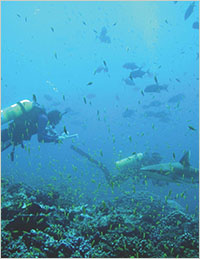-
Home
-
Data & Publications
-
Regional Portals
- About Regional Portals
- Florida
- Navassa Island
- Puerto Rico
- Flower Garden Banks
- U.S. Virgin Islands
- American Samoa
- Commonwealth of the Northern Mariana Islands
- Federated States of Micronesia
- Guam
- Main Hawaiian Islands
- Republic of the Marshall Islands
- Northwestern Hawaiian Islands
- Republic of Palau
- Pacific Remote Island Areas
-
CRCP Activities
- Glossary
Human, Oceanographic and Habitat Drivers of Central and Western Pacific Coral Reef Fish Assemblages

In this study, staff of NOAA Pacific Islands Fisheries Science Center and colleagues examine the relative influence of multiple human, oceanographic and environmental factors on coral reef fish biomass at nearly 40 US and US-affiliated Pacific islands and atolls. Biological data comes from consistent large-scale ecosystem monitoring from the Pacific Reef Assessment and Monitoring Program, which is part of NOAA's National Coral Reef Monitoring Program. In total, the survey involves over 2,000 hours of underwater observation by divers at 1,934 sites. Consistent with previous smaller-scale studies, results show sharp declines in reef fish biomass at relatively low human population density, followed by more gradual declines as human population density increased further. Adjusting for other factors, the highest levels of oceanic productivity among study locations were associated with more than double the biomass of reef fishes (including about 4 times the biomass of planktivores and piscivores) compared to islands with lowest oceanic productivity. Results emphasize that coral reef areas do not all have equal ability to sustain large reef fish stocks, and that what is natural varies significantly amongst locations. Comparisons of biomass estimates derived from visual surveys with predicted biomass in the absence of humans indicated that total reef fish biomass was depleted by 61% to 69% at populated islands in the Mariana Archipelago; by 20% to 78% in the Main Hawaiian islands; and by 21% to 56% in American Samoa.
Citation: Williams, I. D., Baum, J. K., Heenan, A., Hanson, K. M., Nadon, M. O., Brainard, R. E. (April 1, 2015). Human, Oceanographic and Habitat Drivers of Central and Western Pacific Coral Reef Fish Assemblages. PLoS ONE 10(4): e0120516. doi:10.1371/journal.pone.0120516


